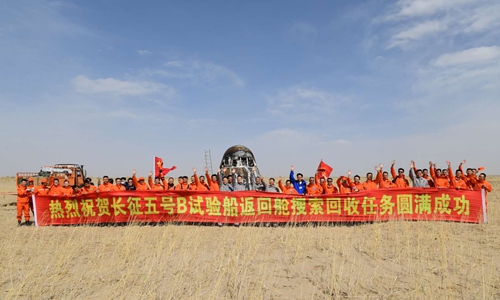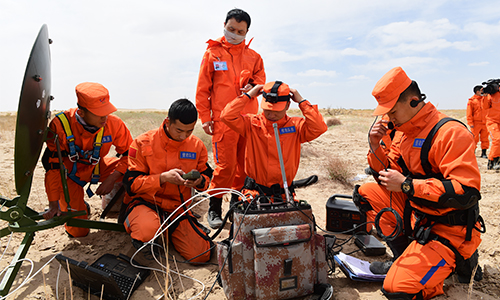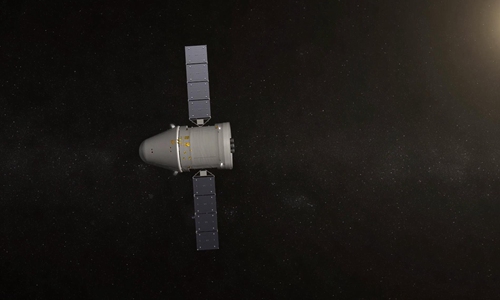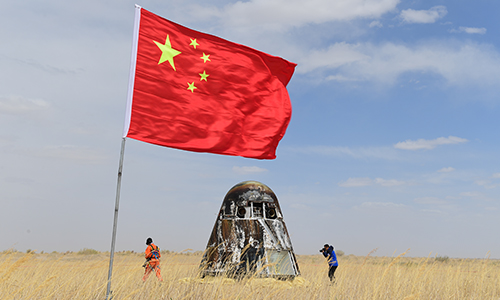Trial version of China's new-generation spaceship safely returns to Earth
By Deng Xiaoci Source:Global Times Published: 2020/5/8 14:12:21 Last Updated: 2020/5/8 18:39:18
Successful maiden flight verifies world-beating capabilities

Photo: Dongfeng Landing Field
The trial version of China's new-generation manned spaceship, which was launched by the Long March-5B in its maiden flight on Tuesday, has successfully made its re-entry to Earth and returned to its designated landing site at 1:49 pm Friday, China's Manned Space Agency announced.
After a flight of two days and 19 hours, re-entry capsule of the new spaceship smoothly returned to the Dongfeng landing site in the desert of North China's Inner Mongolia Autonomous Region on Friday, under the precise direction of the Beijing Aerospace Flight Control Center.
The new spaceship, which is designed with the aim of supporting China's future manned landing mission on the moon, took an unprecedented large elliptical orbit with an apogee of 8,000 kilometers and a perigee of about 400 kilometers, according to the Beijing Aerospace Flight Control Center. During its in-orbit flight, the spaceship adopted a brand-new autonomous orbit control and guided return system.

Photo: Dongfeng Landing Field
The maiden flight mission of the new-generation experimental spaceship has verified that major technical indicators have reached a world-beating level, the Global Times learned from the spaceship developer, the China Academy of Space Technology under state-owned space contractor China Aerospace Science and Technology Corporation (CASC) on Friday.
The academy also revealed that the new spaceship is no less than other international advanced space shuttles, and it possesses the capabilities of adapting to different missions, enhanced mobility in orbit, and can perform landings on both ground and water surfaces.
To ensure the safety and stability of the spaceship's flight, the Beijing center has also designed a series of back-up adjustment strategies to manually re-construct an emergency response orbit within seconds in order to protect the spaceship.
The Beijing center, using real-time data transmitted from the spaceship, has drawn up different plans to respond to normal and emergency re-entry situations. The center had been making forecast reports on the precise landing point while directing the measurement and control stations.

Visual conceptual picture of the new manned spaceship Photo: China Academy of Space Technology
An upgrade, not a replacement
According to a statement provided by its developer, the CASC, compared to the older version spaceship Shenzhou, the new spaceship is not only capable of sending and bringing back astronauts to and from the Chinese space station at an orbit of 400 kilometers above the Earth, it can also perform missions including manned landing on the moon, which is 380,000 kilometers away from the Earth, and even probe into deeper space.
The new spaceship can also bring cargo back to the Earth from the space station, meaning it has a "crew plus cargo" capability, unlike the Tianzhou spaceship, according to the CASC.
The new spaceship is not a replacement for the old one, but the two are meant to complement each other, offering more options for China's manned space projects and meeting requirements for different space missions.
According to the CASC, the new spaceship is reusable, which can reduce costs and solve the issue of how to make space entry more secure, comfortable, smart and economical, which will significantly enhance the country's manned space entry and return transport capability.
The new spaceship is 9 meters in height, weighs 20 tons, and will be able to send six to seven astronauts into Low Earth Orbit (LEO) at one go in the future, the CASC statement said.
The new spaceship is composed of two capsules - a re-entry capsule, which is the command center of the spaceship and also the living space for astronauts, and a service capsule, which is in charge of power supply.
The living space for astronauts in the new vessel is more spacious than on the Shenzhou spaceship, and the re-entry capsule can be separated for different functions according to mission requirements, such as a working zone, an entertainment zone with large interactive screen, and even a dining area, which will make the space journey for astronauts more comfortable.

Photo: Dongfeng Landing Field
In-orbit manufacturing
Space science experiments, including space 3D printing, were conducted in the experimental spacecraft during its flight.
According to the Technology and Engineering Center for Space Utilization, Chinese Academy of Sciences, which designed the experiment, these 3D printing experiment aims to study the possibility of "self-sufficiency" by building parts for the spacecraft in order to address the problem of "long supply lines" during space exploration missions.
The CAS research team told the Global Times in a statement that the 3D print experiment they conducted on board the new spaceship was the first time in the world such technology was adopted to conduct in-orbit manufacturing of metal/ceramic composite materials with a nanometer level precision.
National broadcaster China Central Television (CCTV) reported on Thursday that the experiment was successfully conducted in a microgravity environment.
During the flight, the experiment to establish a super-speed local area network equivalent to 1,000 Mbit/s, across all systems on board the spaceship, was successfully conducted, which marked a national first.
During the experiment, multiple functions including clock synchronization, multi-source data sampling and high-definition image transmission were verified.
Posted in: SOCIETY